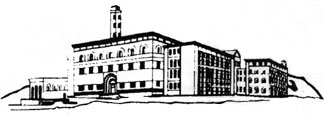 |
Established 1935. |
 |
Established 1935. |
|
Perhaps the events best illustrating the unique nature of Woodbourne were the furious dash to convert the old auditorium in GY dorm, the staff's reaction to the inmate lawsuit contesting double celling in DOCS, and the formation and work of the historical committee.
With the construction of GY Dorm, this was the first facility in all of corrections to have inmates housed in double bunks. A space without any of the needed plumbing or electrical utilities was transformed in less than a week to housing for 148 inmates. The cooperation among employees and departments necessary to accomplish the tremendous work that had to be done exemplifies the spirit of Woodbourne's staff.
Our reaction to double celling took two forms. On the one hand, the employee unions protested double celling through procedural challenges, but on the other hand, all were aware that the legal challenges by inmates could have had a disastrous impact on both Woodbourne and the entire department.
Woodbourne For several months, experts hired by the inmates' attorneys toured and measured and attempted to gather evidence that we were subjecting inmates to inhumane conditions by housing a relatively small number of them two to a cell. The law firm of Fried, Frank, and Harris had taken the case on a pro bono basis, but had the suit been successful, they would have been able to charge DOCS "reasonable" legal fees, which reportedly amounted to $4 million. The expenses of the corrections experts retained to discover all that was wrong in the facility would likewise have been payable by the department, at the rate of $10,000 per day.
Although all staff might not have wholly approved of double celling and the problems it might have created, neither did the Woodbourne workforce approve of having royally paid outsiders come tell us that we didn't know how to run our own facility. In the end, there was virtually nothing that the "experts" could find to take before the judge as an example of how we were mismanaging the prison and violating anyone's constitutional rights.
In January 1998, Federal Judge Sidney Stein ruled entirely in favor of DOCS that the double celling initiative did not constitute cruel and unusual punishment and thus did not violate the constitutional rights of inmates.
As for the authors of this book, until 1998, no formal history of Woodbourne relying on old documents, interviews, and artifacts had ever been attempted. Drawing on both security and civilian staff's talents, the Woodbourne Historical Committee undertook the project. Retirees willingly gave their time to record their memories, and staff worked to publish an accurate and complete record.
[The hardcopy]Journal was printed and bound by the
students of the Vocational Printing Program at
Woodboune Correctional Facility.
To simplify the task of writing the history for the 100th anniversary of Woodbourne, the materials which were used to produce this text, and many which were not, will be put in a time capsule to be opened in 2034 and placed in the Hanslmaier Conference Room. We hope that those writers will enjoy their task as much as we have ours.
The Woodbourne Historical Committee extends special thanks to former Woodbourne employee and Sullivan Correctional Facility retiree Jim Dirie for transcribing taped interviews with fellow retirees, thus making it possible to use their reminiscences in this history.
We want to thank all the current staff, former employees, and retirees who helped by sharing their memories of Woodbourne: Lee Betters, Jim Bonnell, Douglas DePuy, Edward Dill, Sonny Eidel, Rocky Hill, Norman Kowalik, Robert Kuhlmann, Curtis Parks, Herman Probst, Jim Rennison, Art Soule, and Kent VanOstrand.
Many of the ideas implemented by the committee came from DSA T.J. Miller. He first suggested a focus on Woodbourne's architecture and that it be presented as a walking tour of the facility and first put forward the idea of preserving the materials for this history in a time capsule to aid the writers of Woodbourne's 100th anniversary history.
Austin Clarke [then] of Corcraft is the original author of a DOCS Today article on Woodbourne used without other attribution throughout the history. He worked with the New York State Library to find for the committee early reports from the Commission on Corrections to the legislature.
|
To |
To Correction |
To |